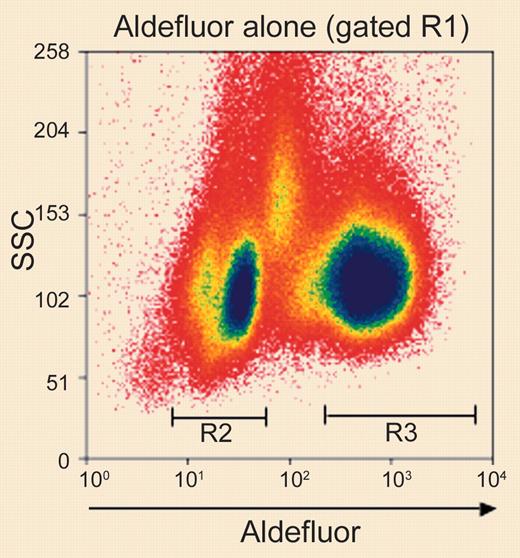Comment on Hess et al, page 1648
Human hematopoietic stem cells with in vivo multilineage reconstitution potential can be isolated based on their high content of aldehyde dehydrogenase, without the need for recognition of cell surface markers.
Functional properties distinguishing hematopoietic stem cells (HSCs) from other cell types are numerous but very few are suitable for the detection and selection of viable stem cells. In this issue of Blood, Hess and colleagues describe the identification and isolation of functional human HSCs based on the expression of cytosolic aldehyde dehydrogenase (ALDH). Although this report does not describe a new distinctive property of HSCs, it offers, for the first time, a detailed and comprehensive characterization of the phenotypic in vitro clonogenic potential and long-term marrow repopulating capacity of lineage-depleted human umbilical cord blood cells fractionated on the basis of their relative expression of ALDH. The use of ALDH to isolate murine and human primitive hematopoietic cells was originally reported several years ago1,2 and high levels of ALDH expression have been described in stem cells other than those of hematopoietic origin.3 Cytosolic ALDH is an intracellular enzyme responsible for oxidizing aldehydes. Acetaldehyde, an intermediate in ethanol metabolism, and vitamin A are 2 of its prominent substrates. Metabolic products of vitamin A participate in the regulation of retinoic acid response elements, which are implicated in many mammalian developmental and growth processes. Hess and colleagues took advantage of the oxidizing power of ALDH and used a fluorescent aldehyde substrate, labeled Aldefluor, to isolate a population of umbilical cord blood cells constituting approximately one thousandth of total mono-nuclear cells contained in this hematopoietic tissue. Depletion of cells expressing lineage markers followed by selection of cells with high ALDH expression (ALDHhiLin-) yielded a group of cells highly enriched for the expression of surface markers commonly associated with a stem cell phenotype including CD34 and CD133. Interestingly, distinct in vivo biologic functions were recognized for ALDHhiLin- cells versus those with low expression of ALDH (ALDHloLin-), especially when compared in 2 disparate animal models. Fewer ALDHhiLin- cells were required to engraft nonobese diabetic/severe combined immunodeficiency β2 microglobulin (NOD/SCID β2M) null mice, known to be permissive for the engraftment of more committed cells, than were required to engraft NOD/SCID mice, suggesting that fractionation of HSCs based on the expression of ALDH yielded a mixture of primitive and more committed progenitors among cells expressing high levels of ALDH. However, ALDHloLin- cells failed to efficiently engraft in either mouse model, demonstrating that ALDHloLin- cells were almost completely devoid of short- and long-term repopulating capacity.FIG1
Identification and isolation of purified ALDHhiLin- and ALDHloLin- cell populations. See the complete figure in the article beginning on page 1648.
Identification and isolation of purified ALDHhiLin- and ALDHloLin- cell populations. See the complete figure in the article beginning on page 1648.
It is not surprising that, although ALDH identified a very small group of hematopoietic cells with reconstitution potential, ALDHhi-Lin- cells were demonstrated to be functionally heterogeneous, reflecting, once again, the hierarchical organization of the stem cell pool. Nevertheless, selection of HSCs with ALDH offers a technique based on stem cell function rather than surface phenotype and may have a clinical appeal not only for hematopoietic stem cells but also for stem cells from other tissues. Unfortunately, the need to couple ALDH selection with flow cytometric cell sorting con siderably limits the clinical applicability of this approach. For scientists, however, ALDH may be more than a stem cell marker, given its potential impact on development and growth, and possibly the stemness of target cells.


This feature is available to Subscribers Only
Sign In or Create an Account Close Modal